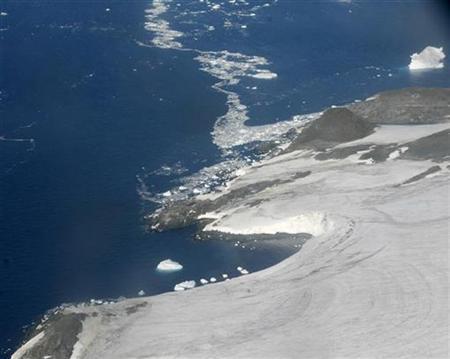Date: 13-Mar-09
Country: US
Author: Deborah Zabarenko, Environment Correspondent

A large floating ice mass is seen in the gateway of the Antarctic
Peninsula March 9, 2008.
Photo: Enrique Marcarian
WASHINGTON - You just don't want to make phytoplankton mad.
These microscopic sea plants are at the bottom of the food chain in the
waters that surround the Antarctic peninsula, and when they're unhappy,
everything that depends on them suffers, including fish, penguins and
possibly, eventually, people.
A new study published on Thursday in the journal Science indicates that some
of these Antarctic phytoplankton have become increasingly grumpy over the
last 30 years.
Like most plants, phytoplankton need food and sunlight to survive. For some
that live off the west coast of the Antarctic peninsula, getting these
essentials has been an increasing challenge, with a 12 percent decrease in
phytoplankton populations seen in the last three decades.
U.S. researchers figured this out by looking at satellite data and tracking
the amount of chlorophyll -- a sign of phytoplankton photosynthesis -- in
the Southern Ocean off the Antarctic peninsula, a long tail of land that
juts out from the main body of the continent and points toward South
America.
This area is a good place to look for signs of climate change, because it is
warming faster than any other place on Earth in the winter.
Phytoplankton are excellent markers for climate change because they respond
quickly, sometimes in as little as a day, to varying environmental
conditions, and because so much of the food chain relies on their survival.
SUNLIGHT MAKES PHYTOPLANKTON HAPPY
Because atmospheric circulation patterns are shifting over the peninsula --
probably due to climate change -- there are now cloudy skies where there
used to be sunshine and vice versa, said study co-author Martin Montes-Hugo
of Rutgers University.
In the southern part of the peninsula, the clouds are decreasing and
sunlight is melting the sea ice, freeing up more open water that sunlight
can shine through, Montes-Hugo said by telephone.
"You have more open water and so you have light penetration, so the
phytoplankton is happy in the south," he said, because like most plants,
phytoplankton need sunlight for photosynthesis.
In the northern part of the peninsula closer to the warm equator there are
more clouds, and sea ice is even more reduced than in the south. Changing
atmospheric patterns are whipping up increasing winds in the area, churning
the ocean water, which enables the phytoplankton to go deeper. At these
deeper levels, the little plants can catch less sunshine.
"This makes phytoplankton mad," Montes-Hugo said. "It's not good for
phytoplankton because you have less light."
Phytoplankton, like other plants, absorb the climate-warming greenhouse gas
carbon dioxide; less phytoplankton means less of this gas will be absorbed.
A decrease in phytoplankton along the Antarctic peninsula results in less
food for krill, the tiny crustaceans that small fish eat, and on up the food
chain to Adelie penguins and other creatures.
Adelie penguins are moving southward because the extreme Antarctic climate
they require is no long present in parts of the peninsula; Chin-strap
penguins that can tolerate warmer temperatures are moving into the area,
Montes-Hugo said.
(Editing by Philip Barbara)
© Thomson Reuters 2009 All rights reserved
